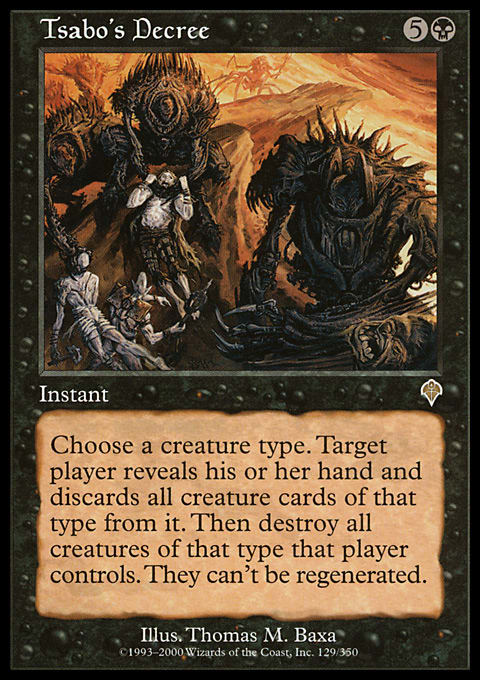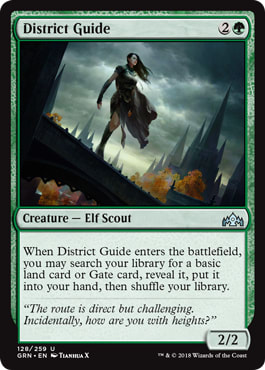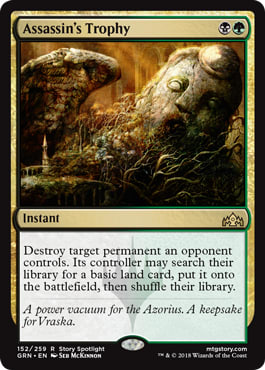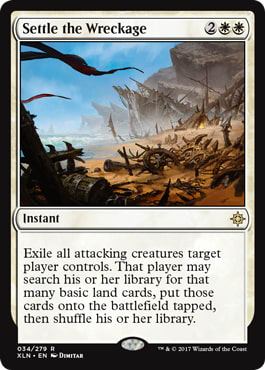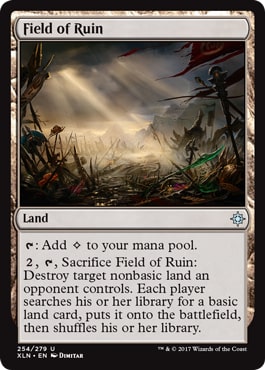1. Splashing Will Be Easier -- and more important -- than it has been in 18 years
It's weird to me that Pro Tour Chicago 2000 was eighteen years ago. It's unlikely we'll ever have another Pro Tour with such an amazing cast of characters in the Top 8. GOAT rivals Kai Budde and Jon Finkel were the (1) and (2) seeds; they were joined by four other Hall of Famers, a National Champion, and (if memory serves) one of only two Triple Crown Champions in that Top 8. The other Triple Crown Champion (himself also a Hall of Famer) had to settle for a Top 16 near-miss.
The 4-5 match in Top 8 featured a brawl between two of Magic's greatest deck designers. It was Blastoderms and Jade Leeches and giant Dragons on both sides of the table. Both men are now Pro Tour Champions... Heck, one of them has won two Pro Tours!
They identified similar cards as being the best to try, but implemented them with vastly different final products.
R/G | Standard | Zvi Mowshowitz, Top 8 Pro Tour Chicago 2000
- Creatures (18)
- 3 Jade Leech
- 3 Two-Headed Dragon
- 4 Birds of Paradise
- 4 Blastoderm
- 4 Llanowar Elves
- Sorceries (5)
- 1 Earthquake
- 4 Assault // Battery
- Enchantments (8)
- 4 Fires of Yavimaya
- 4 Saproling Burst
- Artifacts (4)
- 4 Chimeric Idol
- Lands (25)
- 10 Forest
- 5 Mountain
- 2 Dust Bowl
- 4 Karplusan Forest
- 4 Rishadan Port
- Sideboard (15)
- 3 Earthquake
- 4 Kavu Chameleon
- 3 Flashfires
- 2 Reverent Silence
- 2 Tangle
- 1 Obliterate
Zvi started off with an eight-pack of Birds of Paradise and Llanowar Elves ramping into big threats, topping up on Two-Headed Dragon. He ran twenty-five (25!) lands to boot, powering up the two Dust Bowls that supported his Rishadan Ports.
Zvi came up with a very inventive solution to the Bird / Elf problem of the day: Assault // Battery. Early he could slow down enemy accelerators, and late... It was just another guy (if not the greatest guy).
Perhaps the most defining aspect of Zvi's deck was its focus. Two colors only. Again, that helped him out on the Dust Bowl front.
The Red Zone | Standard | Brian Kibler, Top 8 Pro Tour Chicago 2000
- Creatures (25)
- 2 Rith, the Awakener
- 3 Jade Leech
- 4 Ancient Hydra
- 4 Birds of Paradise
- 4 Blastoderm
- 4 Llanowar Elves
- 4 River Boa
- Instants (3)
- 3 Wax // Wane
- Sorceries (4)
- 4 Armageddon
- Artifacts (4)
- 4 Chimeric Idol
- Lands (24)
- 8 Forest
- 4 Brushland
- 4 City of Brass
- 4 Karplusan Forest
- 4 Rishadan Port
- Sideboard (15)
- 4 Armadillo Cloak
- 3 Kavu Chameleon
- 2 Simoon
- 3 Tsabo's Decree
- 2 Flashfires
- 1 Obliterate
On the other side of the table, Kibler's The Red Zone was a colorful weapon that existed mostly in the tie dyed dreams of its creator.
Like Zvi, Kibler played the predictable eight-pack on turn one, but spread into not only a third, but a fourth, color. In his main deck, Brian topped up on Rith, the Awakener... And played the full four copies of Armageddon.
In his sideboard, he splashed Black for this little number:
-Kibler, to me, over a 2000 AIM chat
Wax // Wane? No big deal. Last week, we talked about how the winner of this Pro Tour, Kai Budde, splashed Green for Wax in his otherwise all-White seventy-five. For Kibler this was almost no splash at all due to his starting out stretched for Rith and Armageddon.
Kibler's execution was exciting.
In the pseudo-mirror, Kibler won with all his interesting angles.
In Game 1 he got out a Blastoderm, then resolved Armageddon. Armageddon, a symmetrical card, doesn't seem like it would give him a huge advantage in this kind of a fight... But hey, he had the 5/5 in play.
In the deciding Game Four, it was Rith, the Awakener wearing Armadillo Cloak for a massive life and positioning swing.
Kibler's dramatic splashes defeated Zvi's discipline.
Splashing in the upcoming format will become more important than it has been in 18 years. The implications to this, from how we construct our mana bases to how we approach long games will inform play patterns for the next several months.
What will drive these changes?
Some of the reasons are obvious.
One of the best new creatures is District Guide.
One of the most exciting new "big" spells is Circuitous Route.
For Green mages, card advantage and acceleration will be met with new opportunities for splashing. That is intuitive... But that is not what will ultimately make splashing so important and accessible.
What will really change things is how the opponent will drive access to more colors. Settle the Wreckage will remain in its important defensive spot... But will be joined by Assassin's Trophy; in a less important (but still important) role will be Field of Ruin.
All together, the opponent will be the bringer of his own doom.
Huh?
Imagine the White Weenie deck, riding Legion's Landing... That suddenly has the juice for Banefire. Imagine the tokens list, rushing into The Red Zone, now with the ability to make the opponent see red, with Red (and no recourse).
There are going to be some cool sideboards in the coming weeks. One stray Mountain or Gate is going to go a long way in winning long games, and long tournaments.
The End of Basic Lands
In this new universe, an important driver of technical play will be management of specifically the opponent's basic lands.
We see this all the time in Modern. Now with the combination of Green accelerators and your own removal / interaction, resource management in long games will be like nothing we've ever seen in Standard.
The initial knock on cards like Path to Exile (Staple multiple formats) was always its concession of card advantage. People started out cool on Path to Exile, then came around more than 90 degrees to "it doesn't matter".
It turns out, it did actually matter a lot of the time. In its original Standard, ![]()
![]() and
and ![]()
![]() creature decks usually played Path to Exile... But might have been loathe to actually cast it. Many games between fair decks were actually decided by resource concession driven by Path to Exile. You might have gotten rid of their Kitchen Finks... But you gave them the fuel to land their Planeswalker or Overrun.
creature decks usually played Path to Exile... But might have been loathe to actually cast it. Many games between fair decks were actually decided by resource concession driven by Path to Exile. You might have gotten rid of their Kitchen Finks... But you gave them the fuel to land their Planeswalker or Overrun.
Many of the same resource considerations are going to be live for Assassin's Trophy. It's a full card. It might not look particularly relevant... But it's going to be relevant, especially early. That land clause is certainly not going to be irrelevant all the time.
What will change over time will be the opponent's ability to access lands in very long games. If the opponent swings at you with ten or so March of the Multitudes tokens... You're probably going to want to Settle the Wreckage them. I mean, if the alternative is taking ten and dying. The opponent will probably get to search up a lot. Maybe even ten! This might make it so that his next March will be for even more tokens gas.
But then what?
The next Settle the Wreckage will be not nearly so costly for you. Maybe he'll search up one or two. Maybe none. At some point, not only will your Settle (or Assassin's Trophy) be "free" ... But the opponent's Circuitous Route will be no Route to anywhere at all.
What's the significance? At some point it might matter. Perhaps there is an opportunity with Fall of the Thran. Decks with a Mountain in the sideboard are going to have MAD Game 2 play relative to those that don't.
But the most important piece?
There are many exciting lands to play in the upcoming Standard. If you're dipping toward them (and necessarily moving away from basics), you're more likely to run out. This can give an edge to the basic land-aware opponent.
Gates Will Be More Important to Mana Bases Than You Currently Think
This might not necessarily mean that Gates will be the most important thing ever... But if you currently value Gates at zero, that is too low.
I think that both of the aforementioned Green search cards - District Guide and Circuitous Route - are going to play Gates sometimes, and they will be important to hide value.
For example, an otherwise non-Red deck that plays a Mountain in the sideboard might also run a main-deck Boros Guildgate. It's close to free as long as you're getting it with your District Guide. There are also strategies that might just want another dual land. All of us have played some version of the non-Gate terrible dual land in the past. Just don't be surprised when (great) Temple Garden and (pretty good) Sunpetal Grove are joined by the odd Selesnya Guildgate.
On a play level (instead of a deck construction one), the presence of Gates will allow players the option to sandbag against future opponent Settle the Wreckage, et al; saving up for a future payoff.
Get Ready for Double Splashes
We talked about splashing a little already... What about Double Splashes?
The problem for this format is that the types of threats are very powerful, but also quite varied in direction.
March of the Multitudes is a go-wide big spell. In the same deck you might find Venerated Loxodon. This is a pseudo-fast, somewhat tall, Crusade with legs. Unless you're talking about a straight Cleansing Nova, the same answers are not good against both cards.
One of them fears a Goblin Chainwhirler; the other invalidates one. One of them sucks against Assassin's Trophy while Assassin's Trophy sucks against the other.
The dilemma is that a lot of these games are going to go long. Sure, there are going to be Red blitz decks, and the ![]()
![]() Tokens are going to completely overwhelm you sometimes. But other games? Both players are just going to be staring at each other gathering material.
Tokens are going to completely overwhelm you sometimes. But other games? Both players are just going to be staring at each other gathering material.
Imagine all the different ways games might forcibly go long. You already know about Teferi long games... But even Teferi is going to have to work Work WORK against an opponent who has Thawed up every basic land. Imagine two March decks up against one another. How do you ever bust through?
Ultimately not very many colors are good at answering every kind of opponent. One solution will be double splashing. A ![]()
![]() deck might touch Black for Assassin's Trophy and Red for Banefire out of the sideboard. A couple of basics (and maybe a couple of Gates) will go a long way.
deck might touch Black for Assassin's Trophy and Red for Banefire out of the sideboard. A couple of basics (and maybe a couple of Gates) will go a long way.
Second Level Mirror Breakers Will Become Necessary
On that note, imagine the most intuitive new deck to come out of Guilds of Ravnica: ![]()
![]() Tokens.
Tokens.
We outlined just a moment ago how, when both mages are making countless tokens... It might be difficult to bust through. The most obvious answer will be to side (or maybe even start) Settle the Wreckage. You don't want a Wrath-Wrath as your first option in a creature deck. You've got your own creatures you need to win with, right? Settle the Wreckage is asymmetrical. Kill all their guys but keep all mine? Where can I sign up?
Here's the problem:
The most intuitive build of Tokens already plays Shalai, Voice of Plenty. Shalai grants hexproof. Settle doesn't get through hexproof. So the worst thing here isn't that they have a counter to your deck; it's that everyone (more or less) has a counter to your counter.
This comes back to the previous point on double splashing. You can try to play with some color discipline, but then you'll miss all the Armadillo Cloaks and Tsabo's Decrees. More saliently, I'd imagine a ![]()
![]() deck that touches Black to kill the opponent's Angel while siding Red for Control.
deck that touches Black to kill the opponent's Angel while siding Red for Control.
Llanowar Elves will STILL not be the best card in Standard
When the last set came out, I made what I thought was a slam dunk prediction: Llanowar Elves would be the top card in the format. It was an understandable hot take. I mean, Llanowar Elves is arguably the strongest card in the format.
So what gives?
There's the next point, but that's kind of beside the point.
![]()
![]() mana bases are going to be optimized to land Legion's Landing on turn one. It's simply tough to get your mana to go in two different directions on turn one. Look for Legion's Landing to be more popular in
mana bases are going to be optimized to land Legion's Landing on turn one. It's simply tough to get your mana to go in two different directions on turn one. Look for Legion's Landing to be more popular in ![]()
![]() just because it's difficult to make your mana go two different directions so early. Unless of course you have one of these:
just because it's difficult to make your mana go two different directions so early. Unless of course you have one of these:
The "color" on Flower is self-correcting.
Goblin Chainwhirler will become the fun police
Remain?
Is it the fun police already?
Goblin Chainwhirler was already the most influential creature in Standard. I think that it will become a border marking the edge of metagame development.
![]()
![]() Tokens has an enormous number of cool new toys, the most powerful of which is March of the Multitudes. But any of that stuff, from Kicked saproling producers to unending numbers of 1/1 Lifelink triggers must respect the Chainwhirler. Heck, I think in another universe Healer's Hawk would be one of the most important sideboard cards... It's fast, it has a meaningful impact on two of the metrics that matter, but again, you can't really plan to play a sideboard card that keels over completely covered by the target matchup's main threat.
Tokens has an enormous number of cool new toys, the most powerful of which is March of the Multitudes. But any of that stuff, from Kicked saproling producers to unending numbers of 1/1 Lifelink triggers must respect the Chainwhirler. Heck, I think in another universe Healer's Hawk would be one of the most important sideboard cards... It's fast, it has a meaningful impact on two of the metrics that matter, but again, you can't really plan to play a sideboard card that keels over completely covered by the target matchup's main threat.
To that end, my prediction is that Goblin Chainwhirler will be the top of the curve for one of the dominant Red rush strategies. Fast, super uninteresting, but ultimately effective. To that end...
Chainwhirler notwithstanding, after some early experimentation, curves will go very very low, and quite high, eschewing the interesting threes
A notable exception will be Sinister Sabotage. That is a three-mana spell with some real metagame staying power. But let me put this a different way...
When I played Skyknight Legionnaire at the Prerelease, that made me want to look up anything that had haste. The coolest Guilds of Ravnica build arounds to me were Skyknight Legionnaire and Sonic Assault.
Is there a heck of a Jeskai aggro hiding in there somewhere? Sonic Assault even has Jump-Start so it can keep you from fading in those games where you have the advantage but feel it slipping away.
The problem is that these cards are going to clog up the wrong aggro hands. I think the successful Red Aggro deck is going to look more like the low to the ground Wizard's Lightning decks we've seen, topped up at Chainwhirler (I mean, there is no more Hazoret or Glorybringer to strive for). Green decks are going to have a lower cost catalyst in Circuitous Route (which is cheaper than the previous Hour of Promise) and a truly gigantic place to go in March of the Multitudes. Those are both signals for very very high top ends.
But the rest? I do think there will be some middle casting cost (call it "three") experimentation, but with some notable exceptions we're going to end up with mostly one and two casting cost spells peppered with a small number of very big ones. Put another way, tons of Emmara, not so much Etrata, curve wise.
Those are my Top 8 predictions for the Standard that is about to start!
LOVE
MIKE













